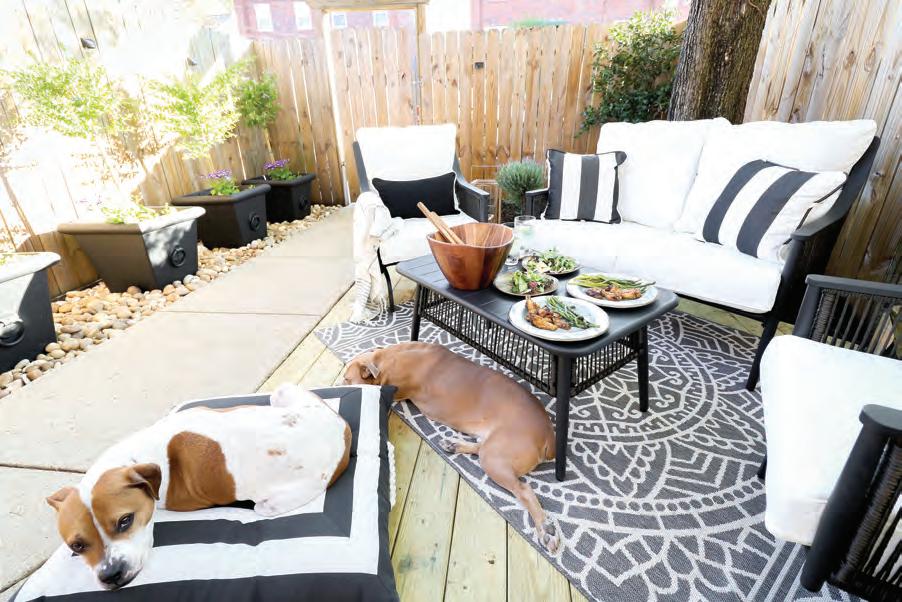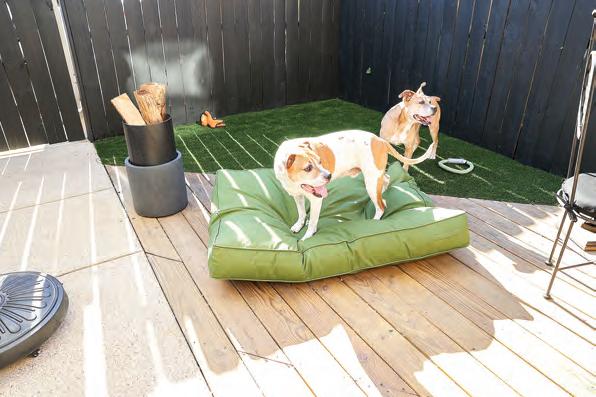
2 minute read
How to turn a small outdoor space into a spot your dog will love
THE WASHINGTON POST
When Rashida Banks renovated the small rear patio of her Washington, D.C., home, she wanted to include a space where her pit bulls, Jax and Chase, could “do their business.”
“We, of course, walk our dogs,” she says, but in between those longer jaunts, she craved the convenience of just opening a door to let them out. Her solution: DIY-ing a section of artificial turf. “When they first encountered the turf, they sniffed it, walked around a bit, but went straight to doing their business,” she says.
A place to pee is one of many considerations when creating an outdoor oasis for a dog – and yes, you can create an oasis, even without a sprawling backyard. “Choose opportunities for enrichment that [your] particular dog or even potentially the breed of dog is more likely to want to engage in,” advises Ciera Moberg, a coowner and behavior consultant at Instinct Dog & Behavior Training. In a compact space, dogs can still be fulfilled if you create surroundings that “mimic how they would engage with the natural environment on their own,” she says.
So, if you’re looking to turn a modest patch of the outdoors into a fun and safe environment for your pup, try including some of these expert-recommended components, all of which are designed to activate the canine senses. (And, of course, none of this is meant to replace taking your dog for a nice long walk.)
Designated potty area
Gravel or “a little patch of grass” are both viable options for a petite potty area, says Kris- tina Carmody, owner and training director at Indigo Dog Training, though she agrees that Banks’s use of fake turf was smart since the material won’t get muddy and is easy to sanitize. “But it does require maintenance, and it does get hot in the sun,” Carmody adds, suggesting that dog owners cool down artificial grass with water on especially warm days.

To install her turf, Banks and her husband dug three to four inches into the ground across a roughly 25-square-foot area, which became quite strenuous.
ABOVE: Rashida Banks used large, heavy planters that her dogs can’t get into.
LEFT: Rashida Banks added to her small D.C. patio artificial turf for her dogs.
“You might think, ‘Oh, that’s not a lot,’ but the whole area has to be dug out at that level, so it does become a bit laborious,” she says.
They hand-tamped the soil before laying down a weed barrier and finely ground stone. After another round of hand tamping, they watered the subbase to ensure an even surface. Meanwhile, the turf was laid outdoors for about two hours, which “softens it up, gets all the wrinkles out and makes it more flexible to work with,” she says.
They secured the turf using six-inch galvanized nails, then brushed sandlike infill over the top. The project took about four days of “working nonstop,” Banks says. (The materials would’ve cost her about $500, including a $140 wheelbarrow, but Banks works as a design influencer and got the supplies gratis from Home Depot.)
Places to dig
If your dog likes to dig, consider creating a spot just for that activity. One method is to hollow out a pit in the ground and fill it with sand or crush-proof balls. But Moberg says a store-bought kiddie pool will also do the trick: “It’s kind of the easiest, temporary way, especially if you don’t want a permanent digging pit in your yard for the wetter months.” Plus, come summer, you can fill the pool with water to give your dog a place to splash and cool off.
Carmody says a children’s portable sandbox with a lid also works well for this purpose. “They’re really sturdy and it’s convenient because you can cover it if it’s going to rain.”
Opportunities to sniff
Tinctures and sprays that emulate scents of animals like possums, pheasants and raccoons can offer stimulation in the yard, “especially for dogs that live in urban environments and don’t necessarily pick up those scents as much as they would if they were living in a more rural
See Dogs, Page 12








